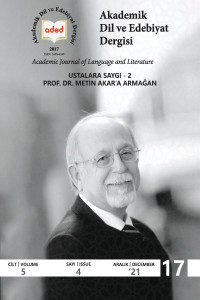Abstract
Women, who have been seen as the source of evil throughout the ages, are also discussed in this aspect in their representations in art and literature. As one of the malevolent female types, the image of the “fatal woman” (femme fatale) that emerged in the nineteenth century is depicted as an important woman who seduces men, surprises them from the right path and drags them into disaster with her charm, beauty and body. With these features, the “mortal woman”, who endanger not only men but also every part of society and shakes the patriarchal order, is either punished or killed in the works. Thus, the malevolent, evil and deadly woman who threatens the man and society is eliminated. In Peyami Safa’s novel Cânân, we see the example of the “deadly woman” image in Turkish literature. In this study, Peyami Safa’s work Cânân published in 1925; How Cânân is evaluated as a deadly woman, how the woman goes through the processes in marriage and love relationships, the frustration of the Turkish man in marriage and love and his regretful return will be examined within the framework of gender and the image of the “deadly woman”. In this work of the author, it is seen that the patterns and boundaries of the patriarchal system are redrawn with the type of “deadly woman”. In the novel, the “mortal woman” Cânân and the “angel woman” Bedia; It appears as the expression of the woman’s life determined as the “the second sex” according to the man. Thus, the “ideal” of male and female roles is determined through the characters. Peyami Safa’s analyzed novel is an indication that the image of the “deadly woman” emerges with patriarchal anxiety.
Keywords
References
- Altun, E. (2019). Türk milliyetçi-muhafazakârlığında mizojini: Peyami Safa’nın romanlarını okumak. [Yayımlanmamış yüksek lisans tezi]. Hacettepe Üniversitesi Sosyal Bilimler Enstitüsü.
- Arpacı, M. (2019), Cinsiyet, kötülük ve beden: femme fatale imgesinin kültürel inşası. Fe Dergi 11, no. 1, 140-154.
- Beauvoir, de S. (1993), Kadın “ikinci cins” I – genç kızlık çağı. Payel Yayınevi.
- Berktay, F. (2010). Yeni kimlik arayışı, eski cinsel düalizm: Peyami Safa’nın romanlarında toplumsal cinsiyet. Kadın Araştırmaları Dergisi, 0 (9), 77-90.
- Doane, M. A. (2008), Femmes fatales: feminism, film theory, psychoanalysis. Routledge.
- Millett, K. (2011). Cinsel politika. Payel Yayınevi.
- Moran, B. (2011). Türk romanına eleştirel bir bakış – 1. İletişim Yayınları.
- Safa, P. (2018). Kadın, aşk, aile. Ötüken Neşriyat.
- Safa, P. (2020). Cânân. Ötüken Neşriyat.
- Tekin, M. (2014). Romancı yönüyle Peyami Safa. Ötüken Neşriyat.
- Žižek, S. (2013). Yamuk bakmak – popüler kültürden Jaques Lacan’a giriş. Metis.
Abstract
Çağlar boyunca kötülüğün kaynağı olarak görülen kadın, sanat ve edebiyattaki temsillerinde de bu yönüyle ele alınmaktadır. Kötücül kadın tiplerinden biri olarak, on dokuzuncu yüzyılda ortaya çıkan “ölümcül kadın” (femme fatale) imgesi, cazibesi, güzelliği ve bedeni ile erkekleri baştan çıkaran, onları doğru yoldan şaşırtan ve faciaya sürükleyen mühlik bir kadın olarak tasvir edilir. Bu özellikleri ile sadece erkekleri değil, aynı zaman toplumun her bir parçasını tehlikeye sokan ve ataerkil düzeni sarsan “ölümcül kadın”, eserlerde ya cezalandırılır ya da öldürülür. Böylece erkeği ve toplumu tehdit eden kötücül, şeytani ve ölümcül kadın ortadan kaldırılmış olur. Peyami Safa’nın Cânân adlı romanında, “ölümcül kadın” imgesinin Türk edebiyatındaki örneğini görürüz. Bu çalışmada Peyami Safa’nın 1925’te yayımlanan Cânân adlı eseri; Cânân’ın ölümcül kadın olarak nasıl değerlendirildiği, kadının evlilik ve aşk ilişkilerinde nasıl süreçlerden geçtiği, Türk erkeğinin evlilik ve aşk hususundaki hüsranı ve pişman olarak geri dönüşü, toplumsal cinsiyet ve “ölümcül kadın” imgesi çerçevesinde incelenecektir. Yazarın bu eserinde, “ölümcül kadın” tipi ile ataerkil sistemin kalıplarının ve sınırlarının tekrar çizildiği görülmektedir. Romanda “ölümcül kadın” Cânân ve “melek kadın” Bedia; kadının “öteki cins” olarak erkeğe göre tayin edilen yaşamının ifadesi olarak karşımıza çıkar. Böylece erkek ve kadın rollerinin “ideali” eser kişileri üzerinden belirlenir. Peyami Safa’nın incelenen bu romanı, “ölümcül kadın” imgesinin ataerkil kaygı ile ortaya çıktığının bir göstergesidir.
References
- Altun, E. (2019). Türk milliyetçi-muhafazakârlığında mizojini: Peyami Safa’nın romanlarını okumak. [Yayımlanmamış yüksek lisans tezi]. Hacettepe Üniversitesi Sosyal Bilimler Enstitüsü.
- Arpacı, M. (2019), Cinsiyet, kötülük ve beden: femme fatale imgesinin kültürel inşası. Fe Dergi 11, no. 1, 140-154.
- Beauvoir, de S. (1993), Kadın “ikinci cins” I – genç kızlık çağı. Payel Yayınevi.
- Berktay, F. (2010). Yeni kimlik arayışı, eski cinsel düalizm: Peyami Safa’nın romanlarında toplumsal cinsiyet. Kadın Araştırmaları Dergisi, 0 (9), 77-90.
- Doane, M. A. (2008), Femmes fatales: feminism, film theory, psychoanalysis. Routledge.
- Millett, K. (2011). Cinsel politika. Payel Yayınevi.
- Moran, B. (2011). Türk romanına eleştirel bir bakış – 1. İletişim Yayınları.
- Safa, P. (2018). Kadın, aşk, aile. Ötüken Neşriyat.
- Safa, P. (2020). Cânân. Ötüken Neşriyat.
- Tekin, M. (2014). Romancı yönüyle Peyami Safa. Ötüken Neşriyat.
- Žižek, S. (2013). Yamuk bakmak – popüler kültürden Jaques Lacan’a giriş. Metis.
Details
| Primary Language | Turkish |
|---|---|
| Subjects | Literary Studies |
| Journal Section | Articles |
| Authors | |
| Publication Date | December 30, 2021 |
| Submission Date | October 21, 2021 |
| Acceptance Date | December 10, 2021 |
| Published in Issue | Year 2021 Volume: 5 Issue: 4 |

